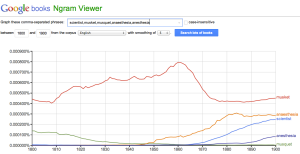WORDCLOUDS– click on “enable editing.”
Word choice is imperative to determine the historical changes in dialect between the 1892 version and the 1984 television screenplay of Sherlock Holmes: The Blue Carbuncle. I’ve developed a deeper understanding of the societal shifts in history using word clouds and the word tools used to construct them.
Similar to Wordle, Voyant and Tagxedo, iLanguageCloud generates a word cloud that enlarges the most frequently used words found in a submitted text. My computer does not allow me to use java programs and, for whatever reason, would not let me update it so my choice in word mapping tools was limited. What I realized is that Java is essential on mobile platforms to navigate through Wordle and Tagxedo leaving Voyant as the only word cloud software tool compatible for both mobile usage and computers without Java installed. This simple inaccessibility is a concern for both Wordle and Tagxedo. These sites need to take in account the amount of mobile users who use their phones primarily for electronic applications and software. Wordle and Tagxedo must develop mobile friendly software to accompany their desktop companions in order to keep up with the digital age. Though I was inable to constitute a Wordle or Tagxedo word map, utilizing my mobile phone, I downloaded the application iLanguageCloud—a high comparable software tool alternative for word cloud creation.
The words: remarked, pray, retained, yes, market and case are used in Arthur Carter Doyle’s original 1892 version of The Blue Carbuncle; the words: foresight, milady, yeah, museum, jewel, God, police, and money are used in John Hawkesworth’s 1984 version. Both sets of words are respectfully divided using the iLanguageCloud software application for the smartphone.
In the first word cloud, generated by iLanguageCloud, we note the shift from “yes” to “yeah” as a formal to informal verbal transition from 1892 to 1984. We can see that “pray” is used in Doyle’s version while “God” is used in Hawkesworth’s version signifying a religious connection between the two. The words “remarked” and “retained” are used only in the 1892 version since they are observational words used by Watson and, being that the 1984 version is told in 3rd person, are of ill usage towards progressing the story. Before moving on to deeper connections, I will introduce the Voyant word cloud I developed using the same two versions of Sherlock Holmes: The Blue Carbuncle.
From an aesthetic standpoint, the iLanguageCloud word map produces an immaculate display of words in a neatly organized in a visually appealing array of spacing. The colors are vivid and the words, though numerous, do not feel squished, scrunched or displeasing to the eyes. This word map features a black background which makes the colorful words pop out, allowing easy readability and engagement. The Voyant word cloud offers an agitating bundle of colors pressed uncomfortably together in front of a white background. Voyant does not have nearly as many words displayed as iLanguageCloud does and yet, the spacing, alignment and design of Voyant’s word cloud is visually atrocious. Voyant offers 5 different colors varied between the multi-sized words framed in its oblate spheroid structure. iLanguageCloud offers around 15 colors that are much more thoughtfully designed, spaced and configured for optical viewing. Though Voyant may be less asthetically pleasing and does offer less words, Voyant displays keywords that iLanguageCloud did not pick up—perhaps more important for some aspects of comparison.
Voyant picked up the words: gas, beer, pounds, money, books, sold and police in John Hawkesworth’s 1984 version. This set of words is not found in Arthur Carter Doyle’s original 1892 version of The Blue Carbuncle. This is because within a century, the world became much more materialistic as commodities naturally became a larger part of our vocabulary, dialect and conversations. It’s interesting to see the word “gas” used in the 1984 version because the first gasoline powered automobile was developed in 1893—one year after Doyle’s version was published. In 1984, “gas” had become a commonly used word after automobiles became a commonplace method of transportation. Using word clouds allows us to infer connections of societal changes between two historical time frames.
Aside from the addition of materialistic references in the 1984 story, both 1984 word clouds suggest an upgraded view of women from the overtly misogynistic view of women in the 1892 version. Although perhaps a small detail, all four word clouds utilize the words (abbreviations) “Mr.” and “Mrs.” However, the word “Mrs.” is significantly larger, and thus more frequently used, in Hawkesworth’s word cloud than Doyle’s. We can infer that as time went by, women became more thoughtfully incorporated characters in Holmes’ stories in opposition to the sexist vision of female characters in 1892, portrayed as inferior for Sherlock’s amusement. iLanguageCloud also highlights the term, “milady,” used to address a woman in a noble manner. This term is found only in the 1984 version because Doyle would not have his male characters address women in this fashion.
Comparing iLanguageCloud and Voyant word clouds, we can identify the historical shift in language usage and its impact on our perception of both versions of Sherlock Holmes. Word cloud users are able to evaluate the context of each version’s social matter to recognize shifts in materialistic terminology as well as the transition to lesser misogynistic viewpoints. While iLanguageCloud offers a more in depth, visually appealing display of word mapping, Voyant offers a similar exhibition of vocabulary that highlights many of the same historical observations used to compare and contrast the century divided time periods of Sherlock Holmes: The Blue Carbuncle.










